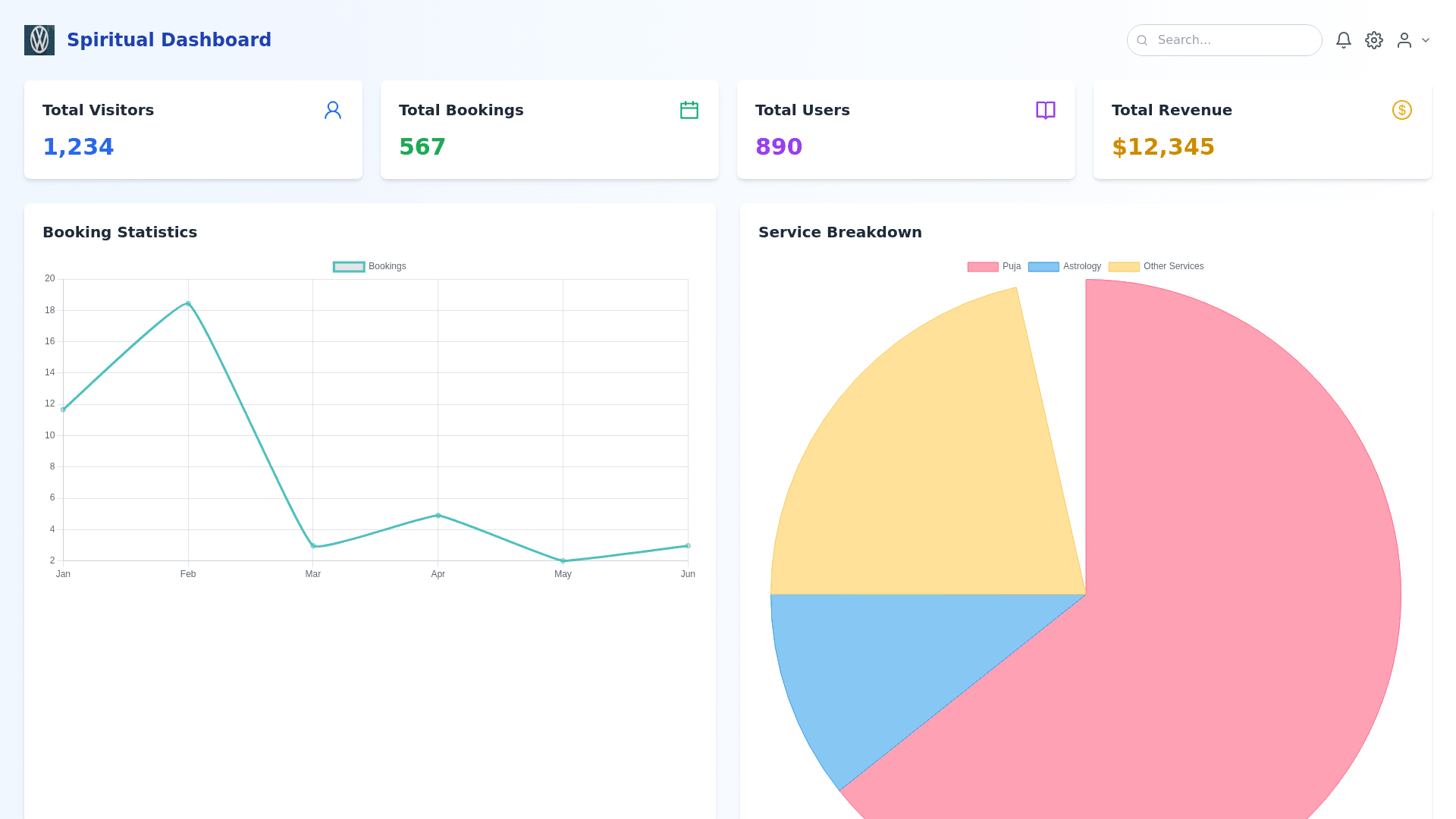Main Content Area - Copy this React, Tailwind Component to your project
Main Content Area Design Overview Overall Style and Aesthetic Use a clean, elegant layout with soft colors such as blues, whites, and subtle gold accents. Incorporate subtle spiritual symbols like lotus, om, or yantras in the background or section dividers for a thematic touch. Employ a flat design with gentle gradients and shadows to add depth without cluttering the interface. Header Section Logo and Title: Keep your logo and the current page title prominently displayed on the left, providing easy recognition. Search Bar: Include a comprehensive search bar with advanced filters to find bookings, users, or services quickly. The search bar should be centrally located or towards the right. Icons for Notifications and Settings: Position notification and settings icons on the right side for quick access, along with a user profile dropdown. Live Stats: Show real time visitor data with a small, unobtrusive live stat ticker. Dashboard Overview (Key Metrics Display) Quick Metrics Cards: Use visually appealing cards to display metrics such as total visitors, total bookings (puja and astrology separately), total users, and total revenue. Booking Statistics: Show line or bar charts that illustrate booking trends over time, allowing administrators to see at a glance how services are performing. Service Breakdown: Pie charts that categorize service usage (e.g., astrology consultations vs. puja services) provide visual insights into the popularity of different services. Recent Activity Feed Activity Log: Create a scrollable activity feed displaying recent bookings, service updates, new user sign ups, and urgent alerts. Actionable Alerts: Highlight any actions required, such as handling disputes, feedback responses, or pending approvals. Detailed Management Pages Bookings Management: Design a responsive table view with sortable and searchable columns. Include action buttons to view, edit, or communicate directly with users or service providers. Service Management: Display a comprehensive list of services with filters for active/inactive status and sorting options. Include buttons for creating or editing services with intuitive form designs. User Management: Show user data in a detailed table with action options for managing accounts. A dedicated user profile view will provide insights into booking history and feedback. Analytics & Reports Visual Analytics: Incorporate dynamic charts and graphs that display booking trends, revenue breakdowns, and user demographics. Performance Insights: Add dashboards showing which services are performing best and peak booking times, helping administrators make data driven decisions. Payments & Sales Management Transaction Overview: Display a summary of recent transactions with the ability to sort, filter, and manage payments. Include action buttons for refunds and dispute management. Revenue Tracking: Line charts or bar graphs showing monthly and yearly sales performance for deeper financial insights. Footer Section A minimalist footer with links to support, FAQs, terms of service, privacy policy, and version details will provide users easy access to essential information without overwhelming the design. UX Enhancements Smooth Transitions: Use soft animations for page transitions and data loading to enhance the user experience. Tooltips: Add tooltips for explaining complex data points or unfamiliar icons. Accessibility Features: Ensure keyboard navigation, adjustable contrast settings, and scalable fonts to enhance usability for all users. Security and Permissions Role Based Access: Implement clear access controls to ensure that different roles (admin, finance, support) have appropriate access to data. Alerts: Use subtle but noticeable alerts for any unauthorized access attempts or other security related notifications. Responsive Design Mobile Optimization: Make sure the dashboard is fully functional on tablets and smartphones, with collapsible menus and scrollable tables to ensure smooth navigation on smaller screens.
